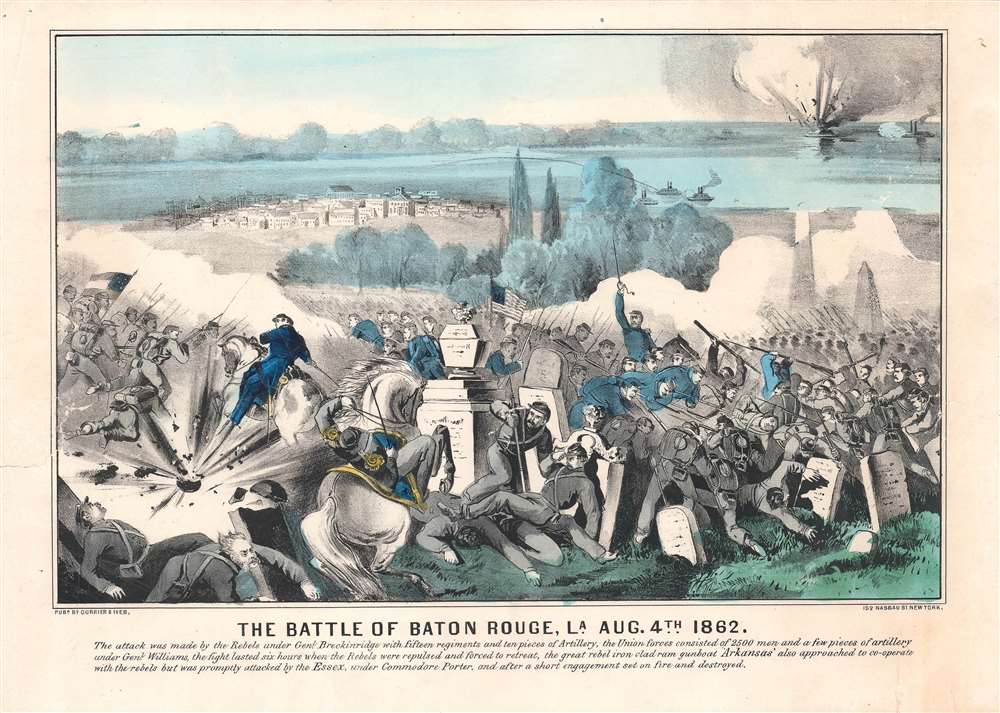1862 Currier / Ives Print of the Battle of Baton Rouge, U.S. Civil War
BattleBatonRouge-currierives-1862
Title
1862 (dated) 8 x 12.5 in (20.32 x 31.75 cm)
Description
A Closer Look
This dramatic battle scene illustrates the intense fighting at Magnolia Cemetery. Union troops, many painted blue, defend against attackers from two sides. Both armies have bayonets fixed for close quarters fighting. At left is a remarkable depiction of the moment just after the explosion of an artillery shell. In the background, the Union Navy provides shells Confederate positions. A Confederate ironclad, the Arkansas, burns in the background after being set on fire by its own sailors and shelled by Union ships.The Battle of Baton Rouge
Part of the wider conflict for Louisiana and control of the Mississippi River, the Battle of Baton Rouge followed the occupation of Union New Orleans in late April 1862. The state government fled a month after the capture of New Orleans, when Union troops moved in. In late July, the Confederates sent a force from Vicksburg to recapture Baton Rouge and, it was hoped, New Orleans.Though the print is dated August 4, the fighting in fact took place the following day, on August 5. The Confederates were well-supplied and facing green Union forces with minimal training under the command of Gen. Thomas Williams. However, Williams had foreknowledge of the attack and naval support, which was ultimately the deciding factor. Union forces successfully repelled the Confederate attack. The Confederate C.S.S. Arkansas, an ironclad, had engine trouble outside Baton Rouge and could not join the battle (it was later scuttled to prevent it being captured by Union forces).
The fierce, close-quarters fighting in the streets of Baton Rouge took a toll on both sides, including the life of Gen. Williams, and both armies retreated after the battle. The battle was notable, however, in securing the Union occupation of New Orleans and weakening Confederate land and naval forces on the Mississippi River, permitting the siege and capture of Vicksburg the following year.
Publication History and Census
This print was published by Nathaniel Currier and James Ives in 1862 or early 1863. We note it among the institutional holdings of seven libraries, museums, and research institutions in the United States.CartographerS
Nathaniel Currier (March 27, 1813 - November 20, 1888) was an American lithographer best known as part of 'Currier and Ives'. Born in Roxbury, Massachusetts, Currier attended public schools until fifteen, when he apprenticed with the Boston lithographic firm of William and John Pendleton. The Pendletons were the first successful lithographers in the United States and were responsible for educating the next generation of lithographic printers. In 1833, Currier left the Pendleton's shop to work with M.E.D. Brown in Philadelphia. A year later, Currier moved to New York City, where he planned to start a business with John Pendleton. When Pendleton backed out, Currier found a new partner, founding 'Currier and Stodart', but the concern survived for just a year. Currier opened his own lithographic studio in 1835 as an eponymous sole-proprietorship. He initially printed the standard materials, including letterheads, sheet music, and handbills. Later in 1835, Currier began issuing current event imagery. Some of his news printers were issued in the New York Sun. By 1840, Currier had moved away from 'job printing' and further toward fine-print publishing. His Awful Conflagration of the Steam Boat 'Lexington', was published in the Sun that year, as well as being separately issued. James Ives (March 5, 1824 - January 3, 1895) began working under Currier in 1850 as a bookkeeper. Ives contributed greatly to the growth of the business, particularly as a manager, marketer, and businessman. Ives became a full partner in 1857, and the firm was renamed 'Currier and Ives'. Currier and Ives produced over 7,500 images and is best remembered for its popular art prints, particularly Christmas scenes and landscapes. They also produced banners, illustrations of current events, views, and historical scenes. Currier retired in 1880 and turned the business over to his son Edward. Currier married Eliza West Farnsworth in 1840, with whom he had one child Edward West Currier. Eliza died in 1843. Currier remarried to Lura Ormsbee in 1847. Other than being a lithographer, Currier also served as a volunteer New York City fireman during the 1850s, and he liked fast horses. More by this mapmaker...
James Merritt Ives (March 5, 1824 - January 3, 1895) was an American businessman, bookkeeper, and lithographer who oversaw the business side of the famed lithographic firm Currier and Ives. Born in New York City, Ives was a self-trained artist who began working at the age of twelve. He married Caroline Clark (1827 - 1896) on June 24, 1846, who was the sister-in-law of Nathaniel Currier's brother, Charles Currier. In 1852, Nathaniel Currier (March 27, 1813 - November 20, 1888) hired Ives as the bookkeeper for his firm N. Currier, Lithographer, on Charles's recommendation. Ives' talent for art and his knowledge of the artistic world soon became apparent to Currier, who valued his insights as well as the business acumen. Currier offered Ives a full partnership in 1857. They renamed the firm 'Currier and Ives' with Ives as the general manager. Ives began to play a role in selecting artists and prints to publish, and was responsible for pursuing publication of scenes of middle-class America that made the firm famous. After Ives died in 1895, his sons continued to work with Currier's son to manage the firm until it was liquidated in 1907. Learn More...

